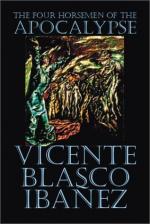But Desnoyers was not there to confirm his mother’s artless opinions. Just as soon as he had found a room in a hotel near the river, he had hastened to the big hostelry, now converted into a hospital. The guard told him that he could not speak to the Director until the afternoon. In order to curb his impatience he walked through the street leading to the basilica, past all the booths and shops with pictures and pious souvenirs which have converted the place into a big bazaar. Here and in the gardens adjoining the church, he saw wounded convalescents with uniforms stained with traces of the combat. Their cloaks were greatly soiled in spite of repeated brushings. The mud, the blood and the rain had left indelible spots and made them as stiff as cardboard. Some of the wounded had cut their sleeves in order to avoid the cruel friction on their shattered arms, others still showed on their trousers the rents made by the devastating shells.
They were fighters of all ranks and of many races—infantry, cavalry, artillerymen; soldiers from the metropolis and from the colonies; French farmers and African sharpshooters; red heads, faces of Mohammedan olive and the black countenances of the Sengalese, with eyes of fire, and thick, bluish blubber lips; some showing the good-nature and sedentary obesity of the middle-class man suddenly converted into a warrior; others sinewy, alert, with the aggressive profile of men born to fight, and experienced in foreign fields.
The city, formerly visited by the hopeful, Catholic sick, was now invaded by a crowd no less dolorous but clad in carnival colors. All, in spite of their physical distress, had a certain air of good cheer and satisfaction. They had seen Death very near, slipping out from his bony claws into a new joy and zest in life. With their cloaks adorned with medals, their theatrical Moorish garments, their kepis and their African headdresses, this heroic band presented, nevertheless, a lamentable aspect.
Very few still preserved the noble vertical carriage, the pride of the superior human being. They were walking along bent almost double, limping, dragging themselves forward by the help of a staff or friendly arm. Others had to let themselves be pushed along, stretched out on the hand-carts which had so often conducted the devout sick from the station to the Grotto of the Virgin. Some were feeling their way along, blindly, leaning on a child or nurse. The first encounters in Belgium and in the East, a mere half-dozen battles, had been enough to produce these physical wrecks still showing a manly nobility in spite of the most horrible outrages. These organisms, struggling so tenaciously to regain their hold on life, bringing their reviving energies out into the sunlight, represented but the most minute part of the number mowed down by the scythe of Death. Back of them were thousands and thousands of comrades groaning on hospital beds from which they would probably never rise. Thousands and thousands were hidden forever in the bosom of the Earth moistened by their death agony—fatal land which, upon receiving a hail of projectiles, brought forth a harvest of bristling crosses!




